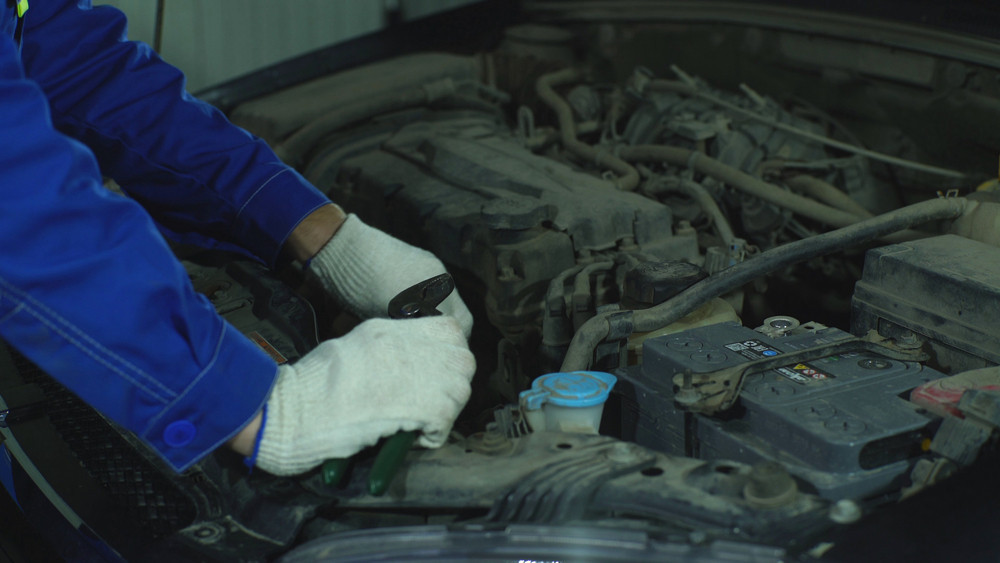How to Tell If It’s Your Battery or Starter Causing Car Trouble
Jefferson, United States - August 4, 2025 / Jefferson Battery Co Inc /
Battery and starter issues share similar symptoms, but some key differences can help you tell them apart.
Clicking sounds, dim lights, or no electrical power often point to battery issues.
A loud clunk, grinding noise, or complete silence when starting may indicate a faulty starter.
You can perform basic tests at home, including a jump-start test and multimeter reading.
Routine maintenance can reduce the risk of both battery and starter problems.
Always inspect wiring and terminals before replacing any parts.
Knowing what to check can save money and prevent unnecessary repair costs.
When your car won’t start, your first thought is usually the battery—or maybe the starter. But how do you know which one it really is? Both parts are vital to your vehicle’s starting system, and when one fails, it can leave you stranded. This article will guide you through how to identify whether you’re dealing with a dead battery or a bad starter and what steps to take next.
Understanding the Basics: What the Battery and Starter Do
Before diving into symptoms, it’s helpful to understand what each component actually does:
Battery Function
Provides the initial power to start the engine
Powers electrical components like lights, radio, and dashboard when the engine is off
Acts as a backup power source when the alternator isn’t generating enough electricity
Starter Function
A small electric motor that turns the engine over
Engages the flywheel to begin the combustion cycle
Requires a significant burst of energy from the battery to function
Understanding the roles of these parts can help you interpret the symptoms more accurately.
Signs of a Failing Battery
The battery is the most common cause of starting trouble, especially in older vehicles or during extreme weather changes. Here’s what to look for:
1. Slow Cranking
When you turn the key, the engine turns over slowly, as if it's struggling. This is one of the clearest signs of a weak battery.
2. Dim or Flickering Lights
Headlights, dashboard lights, and dome lights may flicker or appear dim, especially when trying to start the car.
3. Clicking Sounds
A rapid clicking sound when you turn the key or press the start button is usually a sign of insufficient power reaching the starter.
4. Electrical Malfunctions
Power windows, radio, and other accessories may not work or may work intermittently.
5. Battery Warning Light
If the battery icon lights up on your dashboard, your vehicle’s onboard diagnostics are picking up on charging or voltage problems.
6. Age of the Battery
Most batteries last about 3–5 years. If yours is older than that, it could be near the end of its life.
Causes of Battery Failure
Old age – Even high-quality batteries degrade over time
Extreme temperatures – Both cold and heat can reduce battery capacity
Corrosion – Build-up on terminals can block power flow
Parasitic drains – Electrical issues that drain power when the car is off
Short trips – Frequent short drives don’t allow the alternator to fully recharge the battery
Signs of a Bad Starter
If your battery seems fine but your car still won’t start, the problem may be with the starter. Here are some warning signs:
1. One Loud Click
A single, loud click when you turn the key typically points to a stuck or failing starter solenoid.
2. Grinding Noise
A grinding sound could mean the starter gear isn’t engaging correctly with the flywheel.
3. No Sound at All
If everything is silent when you try to start the car—even though lights and accessories work—the starter motor may have failed entirely.
4. Smoke or Burning Smell
This could indicate an electrical short or the starter motor overheating due to repeated attempts to start.
5. Intermittent Starting
Sometimes the car starts fine, and other times it doesn’t. This inconsistency can be a sign the starter is wearing out.
Common Causes of Starter Failure
Wear and tear – Starters degrade over time due to repeated use
Electrical issues – Damaged wiring or a faulty solenoid
Oil leaks – Oil from the engine can damage starter components
Overheating – Repeated attempts to start the car can burn out the motor
How to Diagnose the Problem Yourself
You don’t need to be a professional mechanic to run a few simple tests that can point you in the right direction.
1. Visual Inspection
Look for corrosion around battery terminals
Check for loose or disconnected wires
Inspect the battery casing—swelling or cracking is a bad sign
2. Test the Lights
Turn on your headlights or interior lights. If they’re dim or fade when you try to start the car, your battery likely doesn’t have enough charge.
3. Jump-Start the Vehicle
If the car starts after a jump, the battery was likely the issue
If it doesn’t, the problem may lie with the starter or another electrical component
4. Use a Multimeter
Measure the voltage across the battery terminals:
12.6V or higher: fully charged
12.4V: acceptable, but not ideal
Below 12.2V: battery is undercharged
Below 12V: battery is likely failing
5. Listen Carefully
Rapid clicks = battery
One click or silence = starter or solenoid issue
Cranking but no start = possibly a fuel or ignition issue, not the battery or starter
6. Tap the Starter
If the starter is stuck, a gentle tap with a wrench or hammer can sometimes free it temporarily. If this works, you’ll still need a replacement soon.
Other Problems That Mimic Battery or Starter Failure
Sometimes the issue isn’t the battery or the starter at all. Consider checking:
Ignition Switch
If it’s faulty, the signal may not reach the starter even when the key is turned.
Neutral Safety Switch
This switch prevents the car from starting unless it’s in Park or Neutral. A faulty switch can block the starter from engaging.
Starter Relay or Fuse
These components control the flow of electricity to the starter. If either fails, the starter won’t activate.
Alternator
If the alternator isn’t charging the battery properly, the battery can die—even if it’s relatively new.
When to Replace the Battery or Starter
Battery Replacement
You should consider replacing your battery if:
It’s older than 4 years
Voltage is consistently low (even after charging)
There’s visible damage or acid leakage
Jump-starting is required frequently
Buying from an auto battery store with wholesale pricing can save you significantly compared to dealership prices.
Starter Replacement
Replace your starter if:
You hear a loud click with no crank
Jump-starting doesn’t help
You’ve tested the battery and it's fine
Tapping the starter helps temporarily
Keep in mind, replacing a starter can be a more involved repair. It may require lifting the car, removing other components, or working around tight engine spaces. If you’re not experienced with automotive work, this might be a job for a professional mechanic.
Preventative Maintenance Tips
Avoid getting stranded by keeping both the battery and starter in optimal condition. These components wear over time, but regular care can extend their lifespan and prevent costly breakdowns. Here's how to stay ahead of problems:
Battery Care
Your battery provides the initial jolt of energy to start your vehicle. Without proper upkeep, it may lose power unexpectedly—especially in extreme temperatures or if the vehicle sits idle too long. Use these strategies to keep your battery healthy:
Clean terminals every few months: Corrosion builds up on the terminals over time, interfering with electrical flow. Clean them using a wire brush and a baking soda solution (1 tablespoon of baking soda in 1 cup of water) to neutralize acid buildup. Always disconnect the battery before cleaning.
Tighten loose battery connections: Loose cables can mimic the symptoms of a dying battery or bad starter. Make it a habit to inspect the terminal clamps and ensure they’re secure after any maintenance or jump-start.
Drive your vehicle regularly: Short trips or long periods without driving can drain your battery. The alternator needs time to recharge the battery—aim to drive at least 15–20 minutes a few times per week.
Don’t leave electronics running when the engine is off: Interior lights, radios, or charging devices can drain the battery when the car isn’t running. Make sure everything is off before you leave your vehicle.
Use a battery tender or maintainer: If you don’t drive regularly or plan to park the car for weeks or months, connect a battery tender. These devices maintain charge without overcharging and are ideal for stored vehicles.
Schedule seasonal tests: Have your battery tested twice a year—especially before summer and winter, when temperature extremes can significantly affect performance.
Starter Care
While the battery supplies the power, the starter motor turns the engine. Starters typically last longer than batteries, but wear and damage can still occur. Here’s how to care for this vital component:
Avoid repeated start attempts: If your engine doesn’t turn over immediately, wait 5–10 seconds before trying again. Continuous cranking can overheat and damage the starter motor.
Don’t ignore warning noises: Strange sounds—like a grinding noise or loud clicking—when turning the key can indicate the starter is failing or its gear isn’t engaging properly with the flywheel. These should be addressed promptly.
Inspect starter wiring and mounts annually: If you do your own oil changes or work on your car, take a few minutes to visually inspect the starter. Look for frayed wires, corrosion, or loose bolts.
Watch for fluid leaks: Oil or transmission fluid dripping onto the starter can cause short circuits or damage. This often happens due to a faulty gasket or seal nearby. Regular checks can catch leaks early.
Have a mechanic check electrical load: During regular service, ask your mechanic to check the starter’s electrical draw. If the starter is working harder than it should, it could be on its way out.
Proactive care of your battery and starter not only saves you from unexpected breakdowns but also helps avoid unnecessary expenses. If you frequently need jump-starts or hear odd sounds during ignition, it’s time for a thorough checkup—or a visit to an auto battery store with wholesale pricing for a quality replacement.
When to Seek Professional Help
Sometimes, the signs can be subtle or overlap. If you've done the basic checks and still can’t determine the issue, it’s best to consult a certified mechanic. Here’s when you should get help:
Your car still won’t start after a jump
Battery tests show full voltage but car won’t crank
Electrical issues persist even after battery or starter replacement
You suspect alternator or wiring issues
You’re not comfortable performing DIY tests or repairs
A professional diagnostic test will often include a battery load test, starter draw test, and alternator performance test—all of which can pinpoint the exact failure.
Final Thoughts
Knowing whether your car trouble is caused by the battery or the starter can save you time, money, and a whole lot of frustration. While they share some symptoms, a careful look at the warning signs and a few simple tests can help you zero in on the real problem.
The battery is usually the more likely culprit—and the easier fix. But when the issue is the starter, acting fast can prevent further damage and get you back on the road sooner.
Take preventive steps to maintain both components, and always check basic issues like corrosion or loose cables before buying new parts. And when in doubt, don’t hesitate to reach out to a professional to make sure the problem gets fixed the right way.

Contact Information:
Jefferson Battery Co Inc
700 Jefferson Hwy
Jefferson, LA 70121
United States
Jefferson Battery
https://www.jeffersonbattery1.com/


